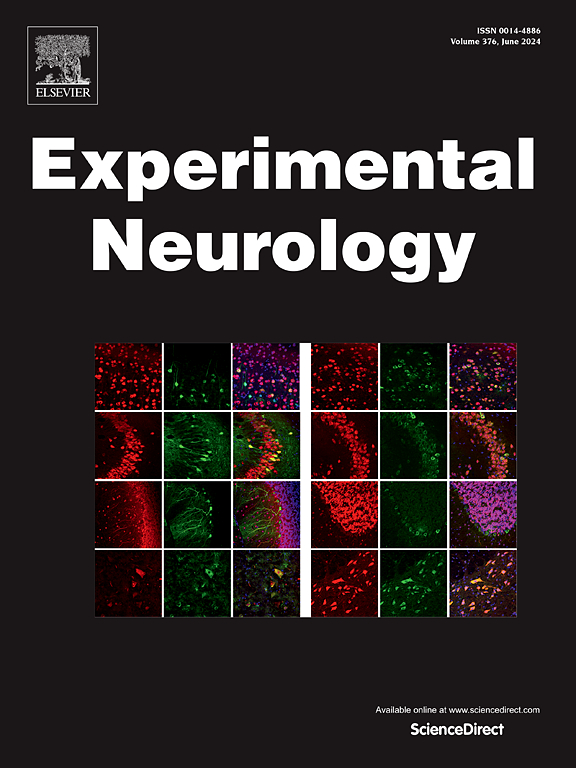抑制cGAS/STING通路引发的海马坏死性下垂与H2S减轻帕金森病认知功能障碍相关
IF 4.6
2区 医学
Q1 NEUROSCIENCES
引用次数: 0
摘要
背景:认知功能障碍是帕金森病(PD)最严重的非运动症状。我们之前的研究表明,硫化氢(H2S)可以改善PD患者的认知功能障碍,但其潜在机制尚不清楚。海马坏死性上睑下垂在认知功能障碍中起着至关重要的作用,而cGAS/STING通路触发坏死性上睑下垂。为了了解H2S在PD认知功能障碍中的抑制作用机制,我们探讨了H2S是否会降低鱼藤酮(ROT)诱导的PD大鼠模型中坏死性坏死的增强和海马cGAS/STING通路的激活。方法:用NaHS(30或100 μmol/kg/d, i.p.)预处理成年SD大鼠7 d,再用ROT(2 mg/kg/d, s.i.i)共处理35 d。采用y形迷宫和Morris水迷宫(MWM)测试评估认知功能。采用苏木精-伊红(H&E)染色检测海马病理形态。Western blotting法检测蛋白表达。采用酶联免疫吸附法测定炎症因子水平。结果:根据y迷宫和MWM测试,NaHS (H2S供体)减轻了rot暴露大鼠的认知功能障碍。NaHS处理还显著下调rot暴露大鼠海马中坏死相关蛋白(RIPK1、RIPK3和MLKL)的表达,降低坏死相关炎症因子(IL-6和IL-1β)的水平。此外,NaHS处理降低了cGAS/STING通路相关蛋白(cGAS、STING、p-TBK1Ser172、p-IRF3Ser396和p-P65Ser536)的表达,降低了rot暴露大鼠海马中促炎症因子(INF-β和TNF-α)的含量。结论:H2S可减轻cGAS/STING通路引发的海马坏死性下垂,这与H2S减轻PD认知功能障碍有关。本文章由计算机程序翻译,如有差异,请以英文原文为准。

Suppression of cGAS/STING pathway-triggered necroptosis in the hippocampus relates H2S to attenuate cognitive dysfunction of Parkinson's disease
Background
Cognitive dysfunction is the most severe non-motor symptom of Parkinson's disease (PD). Our previous study revealed that hydrogen sulfide (H2S) ameliorates cognitive dysfunction in PD, but the underlying mechanisms remain unclear. Hippocampal necroptosis plays a vital role in cognitive dysfunction, while the cGAS/STING pathway triggers necroptosis. To understand the mechanism underlying the inhibitory role of H2S in cognitive dysfunction of PD, we explored whether H2S reduces the enhancement of necroptosis and the activation of the cGAS/STING pathway in the hippocampus of the rotenone (ROT)-induced PD rat model.
Method
Adult Sprague-Dawley (SD) rats were pre-treated with NaHS (30 or 100 μmol/kg/d, i.p.) for 7 days and then co-treated with ROT (2 mg/kg/d, s.i.) for 35 days. The Y-maze and Morris water maze (MWM) tests were used to assess the cognitive function. Hematoxylin-eosin (H&E) staining was used to detect the hippocampal pathological morphology. Western blotting analysis was used to measure the expressions of proteins. Enzyme-linked immunosorbent assay was used to determine the levels of inflammatory factors.
Result
NaHS (a donor of H2S) mitigated cognitive dysfunction in ROT-exposed rats, according to the Y-maze and MWM tests. NaHS treatment also markedly down-regulated the expressions of necroptosis-related proteins (RIPK1, RIPK3, and MLKL) and decreased the levels of necroptosis-related inflammatory factors (IL-6 and IL-1β) in the hippocampus of ROT-exposed rats. Furthermore, NaHS treatment reduced the expressions of cGAS/STING pathway-related proteins (cGAS, STING, p-TBK1Ser172, p-IRF3Ser396, and p-P65Ser536) and decreased the contents of pro-inflammation factors (INF-β and TNF-α) in the hippocampus of ROT-exposed rats.
Conclusion
H2S attenuates the cGAS/STING pathway-triggered necroptosis in the hippocampus, which is related to H2S to attenuate cognitive dysfunction in PD.
求助全文
通过发布文献求助,成功后即可免费获取论文全文。
去求助
来源期刊

Experimental Neurology
医学-神经科学
CiteScore
10.10
自引率
3.80%
发文量
258
审稿时长
42 days
期刊介绍:
Experimental Neurology, a Journal of Neuroscience Research, publishes original research in neuroscience with a particular emphasis on novel findings in neural development, regeneration, plasticity and transplantation. The journal has focused on research concerning basic mechanisms underlying neurological disorders.
 求助内容:
求助内容: 应助结果提醒方式:
应助结果提醒方式:


